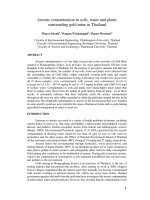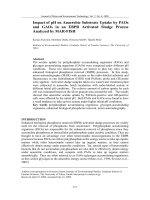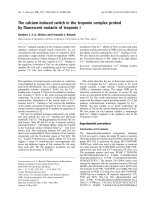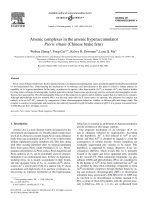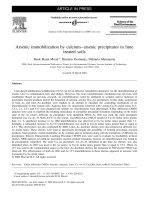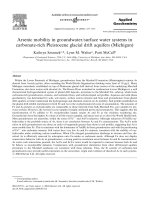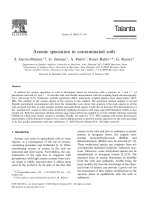Arsenic immobilization by calcium arsenic precipitates in lime treated soils
Bạn đang xem bản rút gọn của tài liệu. Xem và tải ngay bản đầy đủ của tài liệu tại đây (313.51 KB, 15 trang )
ARTICLE IN PRESS
Science of the Total Environment xx (2004) xxx–xxx
0048-9697/03/$ - see front matter ᮊ 2004 Elsevier B.V. All rights reserved.
doi:10.1016/j.scitotenv.2004.03.016
Arsenic immobilization by calcium–arsenic precipitates in lime
treated soils
Deok Hyun Moon*, Dimitris Dermatas, Nektaria Menounou
W.M. Keck Geoenvironmental Laboratory, Center for Environmental Systems, Stevens Institute of Technology,
Castle Point on Hudson, Hoboken, NJ 07030, USA
Accepted 18 March 2004
Abstract
Lime-based stabilizationysolidification (SyS) can be an effective remediation alternative for the immobilization of
arsenic (As) in contaminated soils and sludges. However, the exact immobilization mechanism has not been well
established. Based on previous research, As immobilization could be attributed to sorption andyor inclusion in
pozzolanic reaction products andyor the formation of calcium–arsenic (Ca–As) precipitates. In this study, suspensions
of lime–As and lime–As–kaolinite were studied in an attempt to elucidate the controlling mechanism of As
immobilization in lime treated soils. Aqueous lime–As suspensions (slurries) with varying CayAs molar ratios (1:1,
1.5:1, 2:1, 2.5:1 and 4:1) were prepared and soluble As concentrations were determined. X-Ray diffraction (XRD)
analyses were used to establish the resulting mineralogy of crystalline precipitate formation. Depending on the redox
state of the As source, different As precipitates were identified. When As (III) was used, the main precipitate
formation was Ca–As–O. With As(V) as the source, Ca (OH)(AsO ) •4H O formed at CayAs molar ratios greater
42422
than 1:1. A significant increase in As (III) immobilization was observed at CayAs molar ratios greater than 1:1.
Similarly, a substantial increase in As (V) immobilization was noted at CayAs molar ratios greater than or equal to
2.5:1. This observation was also confirmed by XRD. Lime–As–kaolinite slurries were also prepared at different Cay
As molar ratios. These slurries were used to specifically investigate the possibility of forming pozzolanic reaction
products. Such products would immobilize As by sorption andyor inclusion along with the formations of different As
precipitates. Toxicity Characteristic Leaching Procedure (TCLP) tests were used to evaluate As leachability in these
slurries. XRD analyses revealed no pozzolanic reaction product formation. Instead, As immobilization was found to
be precipitation controlled. The same Ca–As precipitate, Ca–As–O, identified in the lime–As slurries, was also
identified when As ( III) was used as the As source, at CayAs molar ratios greater than or equal to 2.5:1. When As
(V) was used as the contamination source in the lime–As–kaolinite slurries, the formation of NaCaAsO •7.5H O was
42
observed. The effectiveness of both As (III) and As (V) immobilization in these slurries appeared to increase with
increasing CayAs molar ratios.
ᮊ 2004 Elsevier B.V. All rights reserved.
Keywords: X-Ray diffraction (XRD); Arsenite; Arsenate; Lime; Ca–As–O; Ca (OH)(AsO ) •4H O; NaCaAsO •7.5H O
42422 42
*Corresponding author. Tel.: q1-201-216-8097; fax: q1-201-216-8212.
E-mail address: (D.H. Moon).
ARTICLE IN PRESS
2 D.H. Moon et al. / Science of the Total Environment xx (2004) xxx–xxx
1. Introduction
Arsenic (As) is known to be a very toxic
element and a carcinogen to humans (Mollah et
al., 1998). Even trace amounts of As can be
harmful to human health (Karim, 2000). In nature,
As is released in the environment through weath-
ering and volcanism (Juillot et al., 1999). Arsenic
is also released by anthropogenic activities. It was
used extensively for agricultural applications such
as herbicides and insecticides (Leist et al., 2000)
and has thus created problems through leaching
and infiltration to subsurface soils and ground
water (Murphy and Aucott, 1998). Arsenic is also
produced as a waste by-product from the mineral
processing and smelting industries. As (III) and
As (V) are the most widespread forms in nature
(Boyle and Jonasson, 1973; Cherry et al., 1979),
with As (III) being both more mobile and toxic
(Boyle and Jonasson, 1973; Pantsar-Kallio and
Manninen, 1997). More specifically, As (III) is
25–60 times more toxic than As (V)(Dutre and
´
Vandecasteele, 1995; Corwin et al., 1999).
Stabilizationysolidification (SyS) is one of the
most effective methods to reduce the mobility of
heavy metals (Yukselen and Alpaslan, 2001). Var-
ious combinations of type I portland cement
(OPC), lime, type F fly ash, silica fumes, iron (II)
or (III), silicates and blast furnace slag have been
used in the treatment of soils contaminated with
As (Akhter et al., 1997; Leist et al., 2000).
Several researchers have shown that As immo-
bilization is mainly controlled by the formation of
Ca–As precipitates. Dutre and Vandecasteele
´
(1995, 1998), Dutre et al. (1999) and Vandecas-
´
teele et al. (2002) demonstrated that the formation
of Ca (AsO ) and CaHAsO precipitates controls
342 3
the immobilization of As in contaminated soils,
which have been treated with cement, lime and
pozzolanic material. At the high pH levels (12–
13) induced by lime treatment, where a large
fraction of As (III) occurs as HAsO , the precip-
2y
3
itation of CaHAsO will take place. Within the
3
same pH range, the formation of Ca (AsO )
342
occurs in the presence of As(V) ions. These
precipitates were found to be responsible for the
observed reduction in As leachability. Also,
research by Bothe and Brown (1999) has suggest-
ed that lime addition reduces As mobility in
contaminated slurries due to the formation of low
solubility Ca–As precipitates such as
Ca (OH)(AsO ) •4H O and johnbaumite,
42422
Ca (AsO )(OH).
543
Moreover, the reaction of alumino-silicious
material, lime and water results in the formation
of concrete-like products described as pozzolanic
(LaGrega et al., 1994). Dermatas and Meng
(2003) have demonstrated that in quicklime SyS
applications, the formation of pozzolanic reaction
products may be associated with heavy metal
immobilization by sorption and inclusion in poz-
zolanic reaction products. Therefore, there seems
to be three possible As immobilization mecha-
nisms to be considered. These are Ca–As precip-
itation, sorption or inclusion in pozzolanic reaction
products. In this study, the prepared lime–As and
lime–As–clay slurries were tested by X-ray dif-
fraction (XRD) analyses and analyzed for soluble
As in order to evaluate these mechanisms. Kaolin-
ite was chosen as the clay that will provide the
available alumina and silica for the possible for-
mation of pozzolanic reaction products.
The objectives of this study are: (1) to investi-
gate the formation of Ca–As precipitates in lime–
As and lime–As–kaolinite slurries prepared at
different CayAs molar ratios; (2) to investigate
pozzolanic reaction product formation in lime–
As–kaolinite slurries as a function of CayAs molar
ratios; (3) to then correlate soluble As concentra-
tions with the type of crystalline phases (precipi-
tation vs. pozzolanic reaction products) as
identified by XRD analyses; (4) to examine the
possible oxidation of As(III) in contaminated soils
as a result of lime treatment; and (5) to investigate
the aging effect on Ca–As precipitates to evaluate
whether the various phases formed persist or redis-
solve with time.
2. Experimental methodology
2.1. Reagents and materials
Three different commercially available As com-
pounds were used as As contamination sources:
arsenic oxide (As O ), sodium arsenite (NaAsO )
23 2
and sodium arsenate (Na HAsO •7H O). The last
242
ARTICLE IN PRESS
3D.H. Moon et al. / Science of the Total Environment xx (2004) xxx–xxx
two are very soluble and provide two different As
oxidation states, As (III) and As(V). The As (III)
source, As O was chosen because of its low
23
solubility (1.2–3.7 gy100 ml at 20 8C)(Interna-
tional Programme on Chemical Safety, 1997) com-
pared to NaAsO , which is highly soluble. This
2
was done in order to evaluate the difference in
solubility between various As (III) forms present
in the soils. These chemicals were obtained from
Fisher Scientific Company (Suwanee, GA). Kao-
linite was provided by Dry Branch Company (Dry
Branch, GA). Chemical grade hydrated lime
(Ca(OH))powder was obtained from the Belle-
2
fonte Lime Company (Bellefonte, PA).
2.2. Slurry preparation and analysis
Lime–As slurries were prepared at five different
CayAs molar ratios (1:1, 1.5:1, 2:1, 2.5:1 and 4:1).
This was done by using a liquid to solid (L:S)
ratio of 10:1, by weight. Three separate sets of
lime–As slurries were prepared by using three
different As compounds as previously discussed.
Likewise, Bothe and Brown (1999) evaluated the
formation of Ca–As precipitates at CayAs molar
ratios that ranged from 1.5:1 to 2.5:1. The prepared
slurry samples were then aged and periodically
shaken at 20 8C. After 4 days of continuous mixing
using an Orbital incubator (Gallenkamp), a sub-
sample was taken with a 5 ml pipette and filtered
through a 47 mm polycarbonate filter (pore size:
0.4 mm). The residue retained on the filter was
air-dried and characterized by XRD analysis. The
filtrate was analyzed for soluble As concentration.
All the experiments focused on 4-day test
results, but the effect of aging was also considered.
Time allowed for the aging experiments was 4
months for the lime–As O (lime–As(III)) slur-
23
ries. Initial results indicated no significant change
in As concentrations between 4-month and 4-day
samples. Thus, equilibrium was attained within 4
days. As a result, the time allowed for aging was
shortened to 2 months for the lime–NaAsO
2
(lime–As(III)) and 40 days for the lime–
Na HAsO •7H O (lime–As(V)) slurries. At the
242
end of the aging experiments, the same procedure
followed in the initial 4-day experiments was used
with regards to XRD and soluble As concentration
analyses.
Lime–As–kaolinite slurries were prepared at
CayAs molar ratios (1:1, 2:1, 2.5:1 and 4:1)
similar to those used in lime–As slurries. The
amount of kaolinite used for the preparation of the
slurry was 30 g. The As source was NaAsO (10
2
wt.%) and Na HAsO •7H O (10 wt.%). The sam-
242
ples were adequately mixed with water to enhance
the hydration process. All the prepared samples
were cured in plastic bottles at 20 8C for 1 month
in order to enable comparison of data with other
studies. A small portion, approximately 10 g, was
removed and air-dried. A fraction of this portion
was used for XRD analysis.
The effectiveness of lime at immobilizing As in
lime–As–kaolinite slurries was evaluated using
TCLP tests. A fraction of the portion removed and
air-dried from lime–As–kaolinite slurries was used
for this purpose (L:S ratio was 20:1). More spe-
cifically, 60 ml of the extraction fluid (pH 3) was
added to3goftheair-dried sample. After 18 h
of tumbling, the leachate was filtered through a
0.4 mm pore-size membrane filter to separate the
solids from the leachate solution. The leachate
solution was then analyzed and soluble As concen-
trations were measured.
The concentrations of soluble As and TCLP As
were analyzed using an inductively coupled plasma
optical emission spectrometer (ICP-OES)(Varian
Vista-MPX, Palo Alto, CA). A number of blanks
and check standards were prepared with each batch
of samples for quality control purposes.
2.3. X-Ray diffraction analyses
A Rigaku DXR 3000 computer-automated dif-
fractometer was used. Step-scanned XRD data
were collected using Bragg–Brentano geometry.
Diffractometry was conducted at 40 kV and 30
mA using Cu radiation with a diffracted beam
graphite-monochromator. The data were collected
between 5 and 658 in 2
u
with a step size of 0.058
and a count time of 5 s per step. All the samples
were pulverized and sieved through a 200-mesh
sieve (0.075 mm diameter opening) prior to XRD
analyses in order to obtain a uniform particle size
distribution.
ARTICLE IN PRESS
4 D.H. Moon et al. / Science of the Total Environment xx (2004) xxx–xxx
It is important to note that when a phase is not
detected by XRD analyses, this does not mean
that it is not there, but rather that it may be there
only in quantities below the detection limit of
XRD. As a general rule, the detection limit of the
XRD analyses of crystalline phases is considered
to be 5% of the total weight of the mixture.
However, several factors do have a significant
effect on the actual detection limit for any partic-
ular crystalline phase. These factors include:
degree of crystallinity, hydration, surface texture
of the sample, sample weight, particle orientation,
mass absorption coefficients of different minerals,
etc. (Mitchell, 1993). Any of these factors may
have an influence on the resulting peak height and
broadness, and thus the detection limit. Carter et
al. (1987) established a 0.01% detection limit for
quartz and a 0.03% limit for cristobalite. Converse-
ly, pozzolanic mineral phases may very well be
either poorly crystallized or amorphous, especially
at the early stages of formation, which makes their
detection by XRD more difficult.
3. Results and discussion
3.1. Formation of different phases in the lime–As
slurries
Lime–As slurries produced Ca–As precipitates
at all CayAs molar ratios tested. The different
phases identified by XRD and the corresponding
soluble As results at 4-days of mixing and after
aging are summarized in Tables 1 and 2, respec-
tively. XRD patterns are presented in Figs. 1–6
for all lime–As slurries.
In the lime–As O (lime–As(III)) slurries, fol-
23
lowing 4 days of continuous shaking, three major
phases were observed: portlandite (Ca(OH)), cal-
2
cium arsenite (Ca–As–O), and calcite (CaCO )
3
(Table 1 and Fig. 1). Arsenolite (As O ) was only
23
identified at the lowest CayAs molar ratio (1:1),
due to its limited solubility, as shown in Fig. 1
and Table 1. However, at CayAs molar ratios
greater than 1:1, the peaks of arsenolite disap-
peared (Fig. 1). Also, following 4 months of aging,
no arsenolite peaks could be identified for samples
having a CayAs molar ratio of 1:1 (Table 1 and
Fig. 2). Aside from the disappearance of arsenolite
peaks, there were no significant differences in the
observed XRD patterns between the sub-samples
tested following 4 days and 4 months.
For the lime–NaAsO (lime–As(III)) slurries,
2
three major phases were identified by XRD:
Ca(OH) , Ca–As–O, and CaCO (Table 1 and
23
Fig. 3). No NaAsO was identified due to its high
2
solubility (Table 1 and Fig. 3). No obvious differ-
ences were observed in the XRD patterns between
the sub-samples tested at 4 days and 2 months
(Fig. 4). Overall, regardless of the arsenite source
used, whether readily soluble NaAsO or less
2
soluble As O , the same Ca–As precipitate, Ca–
23
As–O, was identified (Table 1).
In lime–Na HAsO •7H O (lime–As(V)) slur-
242
ries, five phases were identified (Table 1 and Fig.
5). CaCO and Ca(OH) were identified at all Cay
32
As molar ratios. Due to its high solubility, no
Na HAsO •7H O was identified (Table 1 and
242
Fig. 5). NaCaAsO •7.5H O was identified at Cay
42
As molar ratios up to 1.5:1. Johnbaumite,
Ca (AsO ) OH, was observed only at a CayAs
543
molar ratio of 1:1. Calcium arsenate hydroxide
hydrate, Ca (OH)(AsO ) •4H O, was observed at
42422
CayAs molar ratios greater than 1:1 (Table 1 and
Fig. 5). Following 40 days of aging,
NaCaAsO •7.5H O was no longer detected by
42
XRD at CayAs molar ratios greater than 1:1.
Ca (OH)(AsO ) •4H O and johnbaumite were
42422
still detected following 40 days of aging (Table 1
and Fig. 6).
Bothe and Brown (1999) also found
Ca (OH)(AsO ) •4H O at CayAs molar ratios
42422
between 2:1 and 2.5:1 as well as minor amounts
of johnbaumite. According to their research, the
formation of johnbaumite was clearly observed in
lime–As(V) slurries at CayAs molar ratios
between 1.7:1 and 1.9:1.
3.2. Formation of different phases in lime–As–
kaolinite slurries
In lime–NaAsO –kaolinite (lime–As(III)–kao-
2
linite) slurries, the formation of Ca–As–O was
observed at CayAs molar ratios greater than or
equal to 2.5:1 (Table 3 and Fig. 7).
Kaolinite is composed of alumina and silica,
which become quite soluble at the high pH levels
ARTICLE IN PRESS
5D.H. Moon et al. / Science of the Total Environment xx (2004) xxx–xxx
Table 1
Mineral formations in lime–As O , lime–NaAsO and lime–Na HAsO •7H O slurries following 4 days of mixing and after aging
23 2 2 4 2
CayAs Lime–As O wAs(III)x
23
Lime–NaAsO wAs(III)x
2
Lime–Na HAsO •7H OwAs(V)x
242
molar Phases Phases Phases
ratio
Phases following 4 days of mixing
1
As O , Ca–As–O, CaCO , Ca(OH)
23 3 2
Ca–As–O, CaCO , Ca(OH)
32
NaCaAsO •7.5H O, Ca (AsO ) OH, CaCO , Ca(OH)
42 543 3 2
1.5
Ca–As–O, CaCO , Ca(OH)
32
4
NaCaAsO •7.5H O, Ca (OH)(AsO ) •4H O, CaCO , Ca(OH)
42 42422 3 2
2 44
Ca (OH)(AsO ) •4H O, CaCO , Ca(OH)
42422 3 2
2.5 444
4 444
Phases after aging
1
Ca–As–O, CaCO , Ca(OH)
32
Ca–As–O, CaCO , Ca(OH)
32
NaCaAsO •7.5H O, Ca (AsO ) OH, CaCO , Ca(OH)
42 543 3 2
1.5 44
Ca (OH)(AsO ) •4H O, CaCO , Ca(OH)
42422 3 2
2 444
2.5 444
4 444
ARTICLE IN PRESS
6 D.H. Moon et al. / Science of the Total Environment xx (2004) xxx–xxx
Table 2
Soluble As concentrations in lime–As O , lime–NaAsO and lime–Na HAsO •7H O slurries following 4 days of mixing and after
23 2 2 4 2
aging
CayAs Lime–As O wAs(III)x
23
Lime–NaAsO wAs(III)x
2
Lime–Na HAsO •7H O wAs(V)x
242
molar As conc. (mgyl) As conc. (mgyl) As conc. (mgyl)
ratio
Soluble As concentrations following 4 days of mixing
1 589 2783 5165
1.5 2.5 40.8 3699
2 2.1 21.2 1739
2.5 0.9 16.6 6.8
4 0.5 3.6 1.5
Soluble As concentrations after aging
1 489 2488 2278
1.5 ND 32.1 1979
2 ND 20.3 1077
2.5 ND 12.7 4.7
4 ND 3.4 1.8
Note-NDsnot detectable.
Fig. 1. XRD patterns for lime–As O slurries with different CayAs molar ratios following 4 days of continuous mixing.
23
induced by lime addition (Keller, 1964). Upon
lime treatment a wide variety of calcium aluminate
silicate hydrate pozzolanic phases will form
depending on reaction conditions (Transportation
Research Board, 1976). Several types of calcium
aluminate hydrate and calcium silicate hydrate
pozzolanic phases have been identified in previous
research that focused on lime treatment of kaolinite
ARTICLE IN PRESS
7D.H. Moon et al. / Science of the Total Environment xx (2004) xxx–xxx
Fig. 2. XRD patterns for lime–As O slurries with different CayAs molar ratios following 4 months of aging.
23
soils and arsenic immobilization (Mitchell and
Dermatas, 1992; Dermatas and Meng, 1996). In
the present study, however, no pozzolanic reaction
products were identified. It is important to note
that such an observation does not exclude the
possibility pozzolanic phases exist within the mix-
ture. If pozzolanic phases do exist within the
mixture, they may be in quantities that are below
the detection limit of XRD analyses. As previously
discussed in the XRD analyses section, many
factors may affect the detection limit of XRD
analyses for any given crystalline phase. The
degree of crystallinity is probably the most appli-
cable factor in this case, since Ca–As precipitates
are more likely to have a higher degree of crystal-
linity than pozzolanic phases. Overall, the lack of
detectable quantities of pozzolanic phases may
suggest that a significant portion of the available
Ca ions were consumed during Ca–As–O forma-
tion and thus could not participate in pozzolanic
reactions.
For the lime–Na HAsO •7H O–kaolinite
242
(lime–As(V)–kaolinite) slurries, the formation of
NaCaAsO •7.5H O, Ca(OH) and CaCO was
42 2 3
confirmed for all samples tested (Table 3 and Fig.
8). Similar to the lime–As(III)–kaolinite slurries,
as discussed in the previous paragraph, no pozzo-
lanic reaction products were detected.
The formation of johnbaumite was only detected
ataCayAs molar ratio of 1:1. No Ca (OH)
42
(AsO ) •4H O was detected, even though its for-
42 2
mation was confirmed by XRD in lime–As(V)
slurries. Ca–As precipitates in the lime–As(V)–
kaolinite slurries were somewhat different from
those found in the lime–As(V) slurries at the same
CayAs molar ratios.
For the first time in a SyS study of arsenic
contaminated soils, a Ca–As–O precipitate was
identified. This formation seems to be closely
associated with decreasing As concentrations.
Some of the Ca–As precipitates observed in this
study confirmed previous research findings. Akhter
et al. (1997) also identified NaCaAsO •7.5H O
42
formation when cement and cement–fly ash bind-
ers were contaminated with sodium arsenate (10
wt.%). NaCaAsO •7.5H O was detected even
42
when As (III) was used as the As source in
cement–fly ash mixes, but not in cement-only
ARTICLE IN PRESS
8 D.H. Moon et al. / Science of the Total Environment xx (2004) xxx–xxx
Fig. 3. XRD patterns for lime–NaAsO slurries with different CayAs molar ratios following 4 days of continuous mixing.
2
mixes. This may indicate that As (III) was oxi-
dized during SyS applications in the presence of
fly ash. However, during the present study, the
oxidation of As could not be confirmed in any of
the precipitates identified. Mollah et al. (1998)
identified a Ca (AsO ) formation when arsenate
342
was treated with Portland cement type-V(OPC-V).
Vandecasteele et al. (2002) and Dutre et al. (1999)
´
also predicted the formation of Ca (AsO ) and
342
CaHAsO precipitates by using the speciation pro-
3
gram MINTEQA2. However, the formation of
CaHAsO has not been established by XRD and
3
no XRD data file describing it currently exists
(JCPDS database). None of these precipitates were
identified during this study. Bothe and Brown
(1999) did not observe the formation of Ca
3
(AsO ) either. They observed Ca (OH)
42 4 2
(AsO ) •4H O and Ca (AsO )(OH) instead,
42 2 5 43
which were also observed herein (Tables 1–3).
3.3. Soluble As concentration in lime–As slurries
and the aging effect
Soluble As concentration results are summarized
in Table 2 and presented in Fig. 9.
In lime–As O (lime–As(III)) slurries, the con-
23
centration of As in solution was 589 mgylata
CayAs molar ratio of 1:1 (Table 1). However,
when the ratio was increased to 4:1, the As
concentration decreased to 0.52 mgyl.
In lime–NaAsO (lime–As(III)) slurries, the
2
As concentration was high (2783 mgyl) at a Cay
As molar ratio of 1:1. The difference in soluble
As concentrations, between lime–NaAsO (lime–
2
As(III)) and lime–As O (lime–As(III)) slurries,
23
can be readily explained by the solubility differ-
ences between the two As contamination sources.
When the CayAs molar ratio was increased to 4:1,
the As concentration in the lime–NaAsO slurries
2
ARTICLE IN PRESS
9D.H. Moon et al. / Science of the Total Environment xx (2004) xxx–xxx
Fig. 4. XRD patterns for lime–NaAsO slurries with different CayAs molar ratios following 2 months of aging.
2
decreased to 3.6 mgyl. Overall, As (III) immobi-
lization in lime–As O (lime–As(III)) and lime–
23
NaAsO (lime–As(III)) slurries was more
2
pronounced at CayAs molar ratios greater than or
equal to 1.5:1 (Fig. 9).
In lime–Na HAsO •7H O (lime–As(V)) slur-
242
ries, the soluble As concentration was very high
(5165 mgyl) at a CayAs molar ratio of 1:1, but
decreased significantly to 1.5 mgylataCayAs
molar ratio of 4:1 (Table 2). Arsenic (V) immo-
bilization was more pronounced at CayAs molar
ratios greater than or equal to 2.5:1.
Soluble As concentrations following the aging
step are also summarized in Table 2 and plotted
in Fig. 9. After 4 months of aging, soluble As
concentrations decreased with increasing CayAs
molar ratios for all slurries tested (Table 2) and
were very low at a CayAs molar ratio of 4:1.
The variable reaction time (aging) appeared to
have an important effect on soluble As concentra-
tions only in lime–As(V) slurries. In lime–As(III)
slurries, no significant differences in soluble As
concentrations were observed between the 4-day
and 4-month results. This indicates that equilibri-
um was probably reached within the first 4 days
(Fig. 9). Conversely, As concentration in lime–
As(V) slurries after aging, at CayAs molar ratios
up to 2.5:1, was significantly reduced when com-
pared to 4-day results (Fig. 9). However, no
significant As concentration reduction was
observed for a CayAs molar ratio of 4:1. These
results indicate that equilibrium was probably not
reached in lime–As(V) slurries and that reactions
were ongoing following 40 days of testing for all
CayAs molar ratios, except for a CayAs molar
ratio of 4:1. This observation requires further
investigation.
Even though the formation of Ca–As–O was
observed in all lime–NaAsO (lime–As(III)) and
2
lime–As O (lime–As(III)) slurries, significant
23
As immobilization in the presence of this precipi-
tate occurs only when CayAs molar ratios are
ARTICLE IN PRESS
10 D.H. Moon et al. / Science of the Total Environment xx (2004) xxx–xxx
Fig. 5. XRD patterns for lime–Na HAsO •7H O slurries with different CayAs molar ratios following 4 days of continuous mixing.
242
Fig. 6. XRD patterns for lime–Na HAsO •7H O slurries with different CayAs molar ratios following 40 days of aging.
242
ARTICLE IN PRESS
11D.H. Moon et al. / Science of the Total Environment xx (2004) xxx–xxx
Table 3
Mineral formations and TCLP As concentrations in lime–As–kaolinite slurries following 1 month curing
CayAs molar ratio Lime–NaAsO –kaolinite
2
Lime–Na HAsO •7H O–kaolinite
242
Phases Phases
1 CaCO , Ca(OH)
32
NaCaAsO •7.5H O, Ca (AsO ) OH,
42 543
CaCO , Ca(OH)
32
2 CaCO , Ca(OH)
32
NaCaAsO •7.5H O, CaCO , Ca(OH)
42 3 2
2.5 Ca–As–O, CaCO , Ca(OH)
32
4
4 44
CayAs molar ratio TCLP As conc. (mgyl) TCLP pH TCLP As conc. (mgyl) TCLP pH
1 2302 6.38 2928 6.34
2 1280 8.97 2061 7.78
2.5 753 9.62 785 7.85
4 12.7 11.59 1.4 11.88
Fig. 7. XRD patterns for lime–NaAsO –kaolinite slurries at different CayAs molar ratios after 1 month curing.
2
greater than or equal to 1.5:1 (Tables 1 and 2). At
aCayAs molar ratio of 1:1, Ca–As–O did form,
but soluble As concentrations remained high (Fig.
9). Therefore, it seems necessary to increase the
amount of lime present in order to decrease As
solubility. This finding could not be confirmed by
XRD, since peak intensities of Ca–As–O
(Figs. 1–4) remained relatively unchanged at the
various CayAs molar ratios tested. This was prob-
ably due to peak overlapping between Ca–As–O,
Ca(OH) and CaCO , which obscured any relative
23
changes in the peak intensities of Ca–As–O.
ARTICLE IN PRESS
12 D.H. Moon et al. / Science of the Total Environment xx (2004) xxx–xxx
Fig. 8. XRD patterns for lime–Na HAsO •7H O–kaolinite slurries at the different CayAs molar ratios after 1 month curing.
242
Fig. 9. Soluble As concentrations in lime–As slurries and aging effect.
ARTICLE IN PRESS
13D.H. Moon et al. / Science of the Total Environment xx (2004) xxx–xxx
Fig. 10. TCLP As release in lime–As–kaolinite slurries.
As already mentioned, several Ca–As precipi-
tates formed in lime–As(V) slurries. However, As
solubility remained high for CayAs molar ratios
up to 2:1 (Table 2 and Fig. 5). Soluble As
concentrations decreased drastically only when
CayAs molar ratios were greater than or equal to
2.5:1 (Table 2 and Fig. 5). Bothe and Brown
(1999) also reported that less than 0.5 mgylofAs
was in solution when the CayAs molar ratio in the
slurries was between 2.2:1 and 2.5:1. The drastic
decrease in As solubility at CayAs molar ratios
greater than or equal to 2.5:1 was also reflected in
the XRD findings. Peak intensities for Ca (OH)
42
(AsO ) •4H O formation (Fig. 5) increased as Cay
42 2
As molar ratios were increased from 1.5:1 to 2.5:1,
whereas for CayAs molar ratios greater than 2.5:1,
peak intensities remained relatively unchanged. In
order to account for peak intensity differences,
changes in the largest (2
u
s11.3)
Ca (OH)(AsO ) •4H O peak were monitored
42422
since no phase overlaps were associated with this
peak.
Following 40 days of aging, the peaks for
Ca (OH)(AsO ) •4H O formation at ratios of
42422
1.5:1, 2:1 and 2.5:1 increased, when compared to
formation peaks at the same CayAs molar ratios
at 4 days. This observation correlates to As con-
centration results at the same molar ratios (Tables
1 and 2). This indicates that with elapsed time,
more As reacts to form additional Ca (OH)
42
(AsO ) •4H O and soluble As concentration
42 2
decreases. When the CayAs molar ratio was 4:1
As concentration was low and did not change with
time.
Overall, in the presence of As O (As(III)) or
23
NaAsO (As(III)), the precipitation of Ca–As–O
2
seems to control As immobilization. In the pres-
ence of Na HAsO •7H O (As(V)),Ca(OH)
242 42
(AsO ) •4H O formation was closely associated
42 2
with a decrease in soluble As concentration. Con-
sequently, As immobilization, in lime–As slurries,
seems to be controlled by the precipitation of Ca–
As phases, whether As exists as As(III) or As(V).
3.4. TCLP As release results for lime–As–kaolinite
slurries
TCLP results for lime–As–kaolinite slurries are
shown in Table 3 and presented in Fig. 10. Similar
ARTICLE IN PRESS
14 D.H. Moon et al. / Science of the Total Environment xx (2004) xxx–xxx
to the lime–As slurries’ soluble As results, TCLP
As concentrations decreased with increasing Cay
As molar ratios for all slurries tested (Fig. 10). In
lime–As(III)–kaolinite slurries, TCLP As was
2302 mgylataCayAs molar ratio of 1:1, but only
12.7 mgylataCayAs molar ratio of 4:1 (Table
3). In lime–As(V)–kaolinite slurries, TCLP As
was 2928 mgylataCayAs molar ratio of 1:1 and
1.4 mgyl when the CayAs molar ratio was 4:1
(Table 3).
In lime–As(III)–kaolinite slurries, at CayAs
molar ratios less than 2.5:1, no Ca–As–O peaks
were detected (Fig. 7). When the CayAs molar
ratio was greater than or equal to 2.5:1, Ca–As–
O was detected. Peak intensities of Ca–As–O
were difficult to determine due to peaks overlap-
ping between Ca–As–O, Ca(OH) and CaCO .
23
Similarly to the lime–As(III) slurry results, pre-
cipitation of Ca–As–O is closely associated with
TCLP As concentration. Consequently, in the
absence of any detectable pozzolanic product for-
mation, it can be concluded that As immobilization
in lime–As(III)–kaolinite slurries is precipitation
controlled.
In lime–As(V)–kaolinite slurries, TCLP As
concentrations decreased with increasing CayAs
molar ratios for all slurries tested (Fig. 10). TCLP
As concentrations were highest (2928 mgyl) at a
CayAs molar ratio of 1:1 and the lowest (1.4 mgy
l) ataCayAs molar ratio of 4:1. At a CayAs
molar ratio of 1:1, NaCaAsO •7.5H O showed the
42
lowest peak intensities. In order to account for
changes in peak intensity differences, the fifth
(2
u
s15.25), sixth (2
u
s15.60) and seventh (2
u
s
29.65) largest NaCaAsO •7.5H O peaks were
42
monitored. There were no overlaps associated with
the respective positions of these peaks. NaCa-
AsO •7.5H O peak intensities increased with
42
increasing CayAs molar ratios for all slurries
tested. This apparent peak increase indicated that
additional amounts of this precipitate formed with
increasing CayAs molar ratios. Since this addition-
al precipitation was accompanied by a significant
decrease in As TCLP concentration (Table 3),it
can be concluded that As immobilization is closely
associated with the formation of this
NaCaAsO •7.5H O precipitate.
42
Overall, in the presence of Na HAsO •7H O
242
(As(V)), NaCaAsO •7.5H O formation was close-
42
ly associated with decreasing TCLP As concentra-
tion. Consequently, since no pozzolanic product
formation was identified, As immobilization was
found to be controlled by precipitation.
4. Conclusions
Lime–As and lime–As–kaolinite slurries pre-
pared at different CayAs molar ratios produced
crystalline precipitate formations that were identi-
fied by XRD analyses. In all the slurries tested,
the redox state of the As source used appeared to
affect the resulting crystalline precipitate, i.e. slur-
ries prepared with As (III) had different precipi-
tates from the slurries prepared with As (V).
Overall, the effectiveness of both As (III) and As
(V) immobilization appeared to increase with
increasing CayAs molar ratios for all slurries
tested.
For the first time, a Ca–As–O precipitate was
identified by XRD. In lime–As slurries, when As
(III) was used, the main precipitate formation was
Ca–As–O, irrespective of the solubility of the
As(III) source. Moreover, the oxidation of As(III)
could not be confirmed in any of the precipitates
identified. When As (V) was used, however,
Ca (OH)(AsO ) •4H O formed. XRD analyses
42422
on lime–As–kaolinite slurries revealed no forma-
tions of pozzolanic reaction products. Instead, As
immobilization was confirmed to be precipitation
controlled. Again, Ca–As–O was identified in the
presence of As (III), whereas NaCaAsO •7.5H O
42
formed in the presence of As (V).
Aging had an important effect on soluble As
concentrations only in lime–As(V) slurries with
CayAs molar ratios up to 2.5:1. Equilibrium was
probably not reached in lime–As(V) slurries and
reactions were ongoing following 40 days of aging
for all Cay As molar ratios, except for a CayAs
molar ratio of 4:1.
For the lime–As(V) slurries, the formation of
Ca (OH)(AsO ) •4H O was closely associated
42422
with very low soluble As concentration. However,
this phase was not observed in lime–As–kaolinite
slurries. Instead, the formation of NaCaAsO •7.5
4
H O was observed and coincided with decreasing
2
TCLP As concentrations. The formation of Ca–
ARTICLE IN PRESS
15D.H. Moon et al. / Science of the Total Environment xx (2004) xxx–xxx
As–O found in lime–As and lime–As–kaolinite
slurries coincided with low soluble As and low
TCLP As concentrations, respectively. Therefore,
it could be concluded that As (As(III) or As(V)),
immobilization in lime stabilized soils is controlled
by the precipitation of Ca–As phases.
Acknowledgments
The authors would like to thank Dr Mike S.
Dadachov for helpful comments related to XRD
interpretation. We would also like to thank
Mohammed Sharaf for his critical review of the
manuscript.
References
Akhter H, Cartledge FK, Roy A, Tittlebaum ME. Solidifica-
tionystabilization of arsenic salts: effects of long cure times.
J Hazard Mater 1997;52:247–264.
Bothe JV, Brown PW. Arsenic immobilization by calcium
arsenate formation. Environ Sci Technol 1999;33:3806–
3811.
Boyle RW, Jonasson JR. The geochemistry of arsenic and its
use as an indicator element in geochemical prospecting. J
Geochem Explor 1973;2:251–296.
Carter JR, Hatcher MT, Di Carlo L. Quantitative analysis of
quartz and cristobalite in bentonite clay based products by
X-ray diffraction. Anal Chem 1987;59:513–519.
Cherry JA, Shaikh AU, Tallman DE, Nicholson RV. Arsenic
species as an indicator of redox conditions in groundwater.
J Hydrol 1979;43:373–392.
Corwin DL, David A, Goldberg S. Mobility of arsenic in soil
from the rocky mountain arsenol area. J Contaminant
Hydrology 1999;39:35–38.
Dermatas D, Meng X. Stabilizationysolidification (SyS) of
heavy metal contaminated soils by means of a quicklime-
based treatment approach. In: Gilliam TM, Wiles CC,
editors. Stabilization and solidification of hazardous, radio-
active, and mixed wastes, vol. 3, ASTM STP 1240. Amer-
ican Society for Testing and Materials, West Conshohocken,
Pennsylvania, 1996; pp. 499–513.
Dermatas D, Meng X. Utilization of fly ash for stabilizationy
solidification (SyS) of heavy metal contaminated soils. J
Eng Geol 2003;2189:1–18.
Dutre V, Vandecasteele C. Solidificationystabilization of arsen-
´
ic-containing waste: leach tests and behavior of arsenic in
the leachate. Waste Manage 1995;15:55–62.
Dutre V, Vandecasteele C. Immobilization mechanism of arsen-
´
ic in waste solidified using cement and lime. Environ Sci
Technol 1998;32:2782–2787.
Dutre V, Vandecasteele C, Opdenakker S. Oxidation of arsenic
´
bearing fly ash as pretreatment before solidification. J
Hazard Mater 1999;B68:205–215.
International Programme on Chemical Safety, International
chemical safety cards, 0378, 1997.
Juillot F, Ildefonse P, Calas G, de Kersabiec AM, Benedetti
M. Remobilization of arsenic from buried wastes at an
industrial site: mineralogical and geochemical control. Appl
Geochem 1999;14:1031–1048.
Karim M. Arsenic in groundwater and health problems in
Bangladesh. Water Res 2000;34:304–310.
Keller WD. Processes of origin and alteration of clay minerals.
In: Rich CI, Kunze GW, editors. Soil clay mineralogy.
Chapel Hill: University of North Carolina Press, 1964. p.
3–76.
LaGrega DM, Buckinghm PL, Evans JC. Hazardous waste
management. Hightstown, New Jersey: McGraw-Hill Inc,
1994. p. 1146
Leist M, Casey RJ, Caridi D. The management of arsenic
waste: problems and prospects. J Hazard Mater
2000;B76:125–138.
Mitchell JK, Dermatas D. Clay soil heave caused by lime-
sulfate reactions. Innovations in uses for lime. ASTM STP
1135. American Society for Testing and Materials, Philadel-
phia, PA, 1992; pp. 41–64.
Mitchell JK. Fundamentals of soil behavior. New York, NY:
John Wiley and Sons, Inc, 1993. p. 437
Mollah MYA, Lu F, Cocke DL. An X-ray diffraction (XRD)
and fourier transform infrared spectroscopic (FT-IR) char-
acterization of the speciation of arsenic ( V) in portland
cement type-V. Sci Total Environ 1998;224:57–68.
Murphy EA, Aucott M. An assessment of the amounts of
arsenical pesticides used historically in a geographical area.
Sci Total Environ 1998;218:89–101.
Pantsar-Kallio M, Manninen PKG. Speciation of mobile arsen-
ic in soil samples as a function of pH. Sci Total Environ
1997;204:193–200.
Transportation Research Board. State-of-Art: Lime Stabiliza-
tion, Reaction, Properties, Design, Construction. Transpor-
tation Research Circular 1976; p. 180.
Yukselen MA, Alpaslan BJ. Leaching of metals from soil
contaminated by mining activities. J Hazard Mater
2001;B87:289–300.
Vandecasteele C, Dutre V, Geysen D, Wauters G. Solidifica-
´
tionystabilization of arsenic bearing fly ash from the met-
allurgical industry. Immobilization mechanism of arsenic.
Waste Manage 2002;22:143–146.
